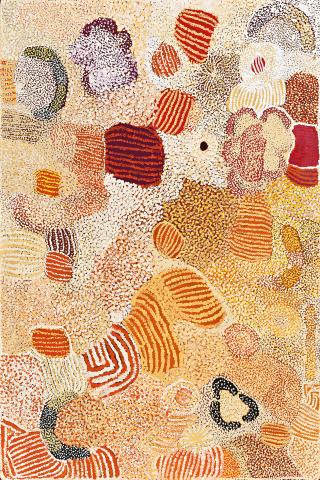PARWALLA, 2001
ELIZABETH NYUMI NUNGURRAYI
synthetic polymer paint on linen
180.0 x 120.0 cm
bears inscription verso: artist’s name, size and Warlayirti Artists cat. 727/01
Warlayirti Artists, Balgo Hills
Raft Artspace, Darwin
The Collection of Colin and Elizabeth Laverty, Sydney, acquired from the above in September 2001
The Collection of Colin and Liz Laverty of Sydney, The Australian Club, Melbourne, 30 June –16 September 2011
Beyond Sacred: Recent Painting from Australia’s Remote Aboriginal Communities: The Collection of Colin and Elizabeth Laverty, Hardie Grant Books, Melbourne, 2008, p. 117 (illus.)
Beyond Sacred: Recent Painting from Australia’s Remote Aboriginal Communities: The Collection of Colin and Elizabeth Laverty, edition II, Kleimeyer Industries Pty Ltd, Melbourne, 2011, p. 129 (illus.)
Parwalla, 2001, synthetic polymer paint on linen, 180.0 x 120.0 cm, private collection, Sydney reproduced in Perkins, H., ‘Elizabeth Nyumi Nungurrayi’, in Carlos, I., On Reason and Emotion, exhibition catalogue, Biennale of Sydney, Sydney, 2004, p. 165
A closely associated painting to Parwalla, 2001, by the same title, painted in the same year, was selected for the 2004 Biennale of Sydney. Together with two other works by Nyumi, it was shown at the Museum of Contemporary Art as part of a large international group exhibition. In the accompanying catalogue essay, Hetti Perkins defines this as ‘the most resolved series of paintings in her ongoing preoccupation with the country of her childhood’.1 Indeed, this work exemplifies the physical and spiritual connection of the artist to her country, in a symbiotic relationship that informs the entirety of Nyumi’s artistic output. Parwalla is the country where Nyumi lived as a child with her mother, before losing her in a tragic accident. After this, Nyumi led a nomadic existence with her father and family group, ultimately settling in the Wirrimanu community at Balgo, where she commenced painting in 1987 for the Warlayirti Artists cooperative.
The symbols depicted in Nyumi’s works are inherently feminine. She represents campsites, bush tucker, native flora and fauna and women’s food-gathering implements. These themes are rendered in a delicate, jewel-like style and soft palette of pastel yellows, oranges, pinks and creams, removed from the vigorous, painterly style and bright colours idiosyncratic to Balgo. Perkins highlights the influence of Nyumi’s matrilineal Pintupi heritage, and associates her with that extraordinary generation of desert women artists, beginning in the 1980s with Emily Kame Kngwarreye, followed by Pintupi artists at Kintore and Kiwirrkurra and spectacularly reinvented by the women artists at Warlayirti.2
Indigenous artists from several remote communities and urban Aboriginal artists had been represented in previous Biennales, but this was the first time for an artist from Balgo.
1. Perkins, H., ‘Elizabeth Nyumi Nungurrayi’, in Carlos, I., On reason and emotion, exhibition catalogue, Biennale of Sydney, Sydney, 2004, p. 162
2. Ibid.
ELENA SCOTT
